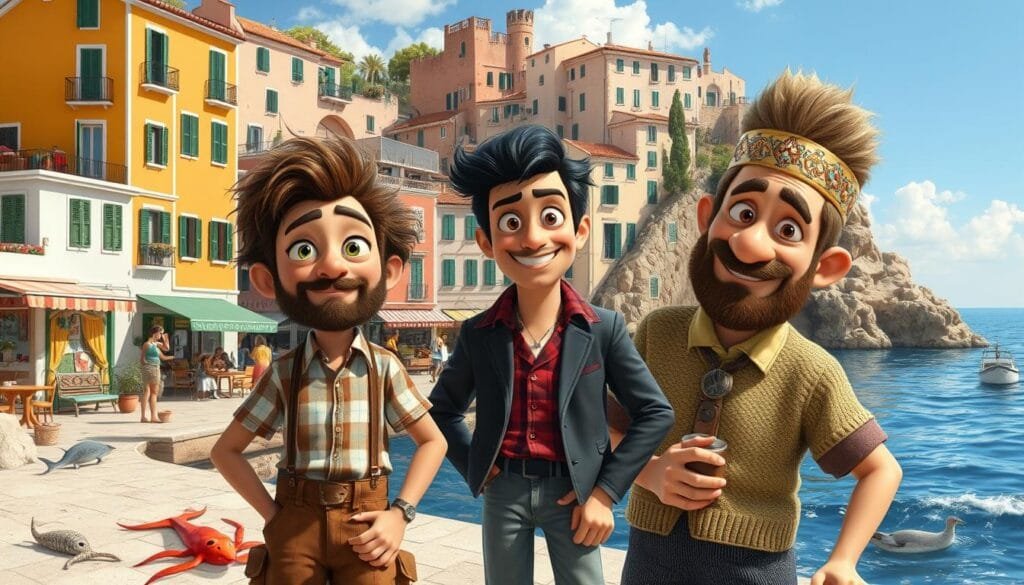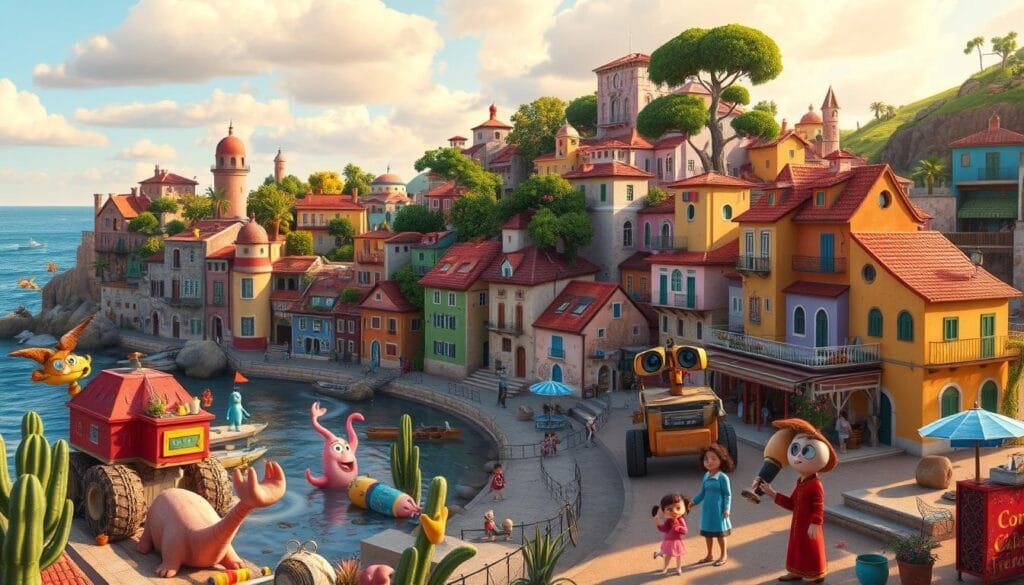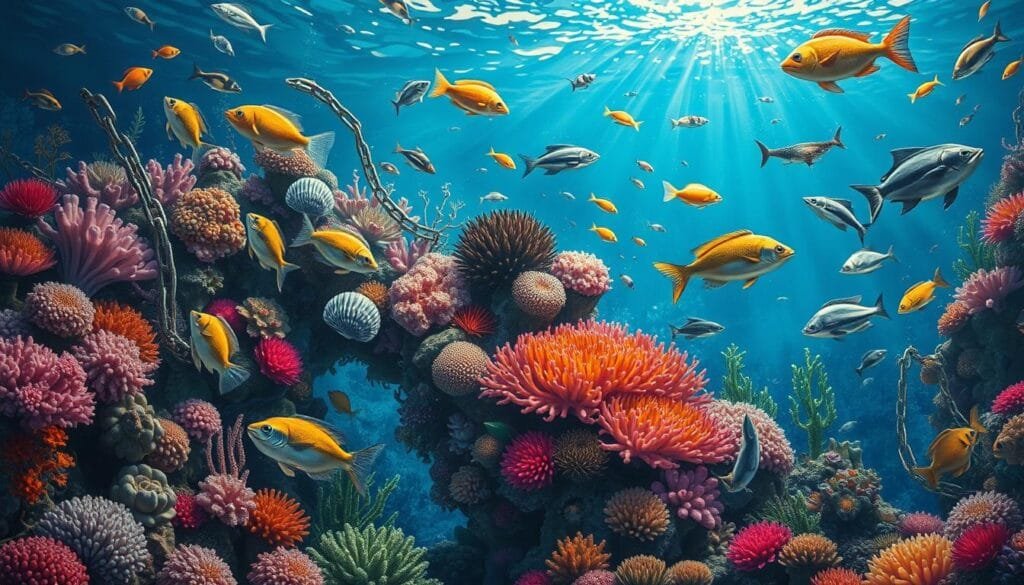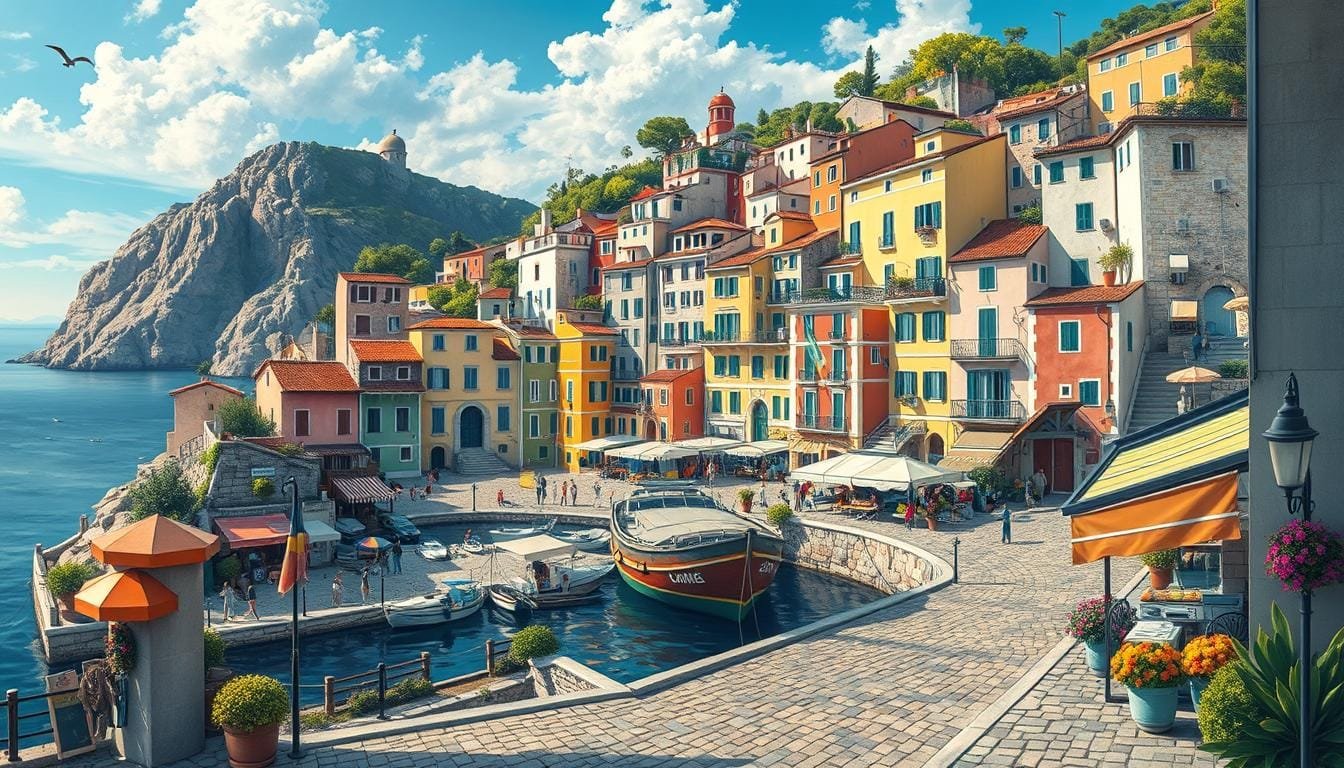Does “Luca” truly show Italian culture, or is it just American stereotypes? This movie by Enrico Casarosa combines Italian culture with fantasy. We wonder if it’s accurate or filled with clichés. It also starts conversations on cultural representation and minority identity.
“Luca” is more than a cartoon. It shows Italian culture by the sea with Pixar’s storytelling. Since its release on June 18, 2021, it has a 91 percent critic score on Rotten Tomatoes. The audience has given it an 87 percent approval rating. This shows how much people enjoy the film.
Key Takeaways
- “Luca” mixes Italian culture with American fantasy elements.
- It has a high score of 91% from critics on Rotten Tomatoes.
- The story delves into otherness and acceptance as society changes.
- Enrico Casarosa focuses on showing real Italian life, like traditional meals.
- Its themes are meaningful to minorities, offering hope for being accepted.
Introduction to “Luca” and Its Setting
“Luca” is directed by Enrico Casarosa and produced by Pixar. It brings us to a fictional Italian town called Portorosso. The story combines the vibrant Mediterranean environment with a touching tale. It’s about a young sea monster named Luca discovering life above water. The adventure of Luca’s self-discovery and acceptance is beautifully told. You can learn more in this overview of the plot.
Portorosso mirrors the Italian Riviera and gives a stunning background to the film. Luca, with his friends Alberto and Giulia, explores this charming town. This lets viewers appreciate the deep cultural roots and themes in the story. The film’s Italian cultural elements and memories from Casarosa’s childhood make the characters’ experiences feel real and touching.
The homage to Italian culture is fundamental to the story of “Luca.” The plot includes elements from classic Italian films and the unique style of Hayao Miyazaki. Casarosa was inspired by his own childhood in Italy to create Portorosso. Pixar’s research trips to Italy in 2016 and 2019 helped make the setting authentic.
The film vividly contrasts the underwater world with sunny Portorosso. It uses distinct colors to show Luca’s worlds. The sea monster world has blues and greens, while Portorosso has warmer tones. This helps tell Luca’s internal and external stories. The detailed design work and character-driven story went through over 30 versions. This was to make sure everything felt real yet relatable.
About 90% of the character designs make the townsfolk seem like real, working-class people. This connects Luca’s magical background with the real-life ups and downs of being human. Because of changes in how we watch movies, “Luca” was released on Disney+ on June 18, 2021. This move shows how digital streaming is becoming more popular.
“As we dive into “Luca,” its charm shines through not just in the plot. It’s also in how it shows friendship, culture, and accepting who you are.”
The beautiful scenes of Portorosso and its detailed sea monster world tell a powerful visual and emotional story. This plot summary shows us a story filled with inspiration, fond memories, and the celebration of cultural identity. It speaks to audiences of all ages.
Exploring the Cultural Nuances in “Luca”
The film “Luca” takes a deep dive into Italian life, showcasing representation of Italian culture vividly. It’s set in the 1950s, capturing coastal Italy’s beauty and lively village scenes. Yet, it carefully avoids Italian stereotypes, aiming to connect truthfully with viewers.
“Luca” draws heavily from classic Italian films and real-life culture. It mixes imaginative storytelling and real cultural references well. Yet, some argue it leans a tad towards Americanization, which might water down its cultural richness.
The movie focuses on giving a balanced view of its characters, avoiding clichéd Italian behaviors. Centering on friends Luca, Alberto, and Giulia, it discusses empathy, understanding, and acceptance. Their summer adventures break cultural boundaries. A detailed exploration of these themes is found in articles like this one.
This film does well in balancing cultural truth and steering clear of stereotypes:
| Aspect | Authenticity | Stereotyping |
|---|---|---|
| Character Behavior | Balanced and relatable | Over-exaggerated traits |
| Setting | Inspired by real Italian locations | Generic ‘Italian’ ambiance |
| Language and Dialogues | Incorporation of Italian phrases | Heavy reliance on clichés |
“Luca” provides a fresh perspective on representation of Italian culture. It walks the line between being authentic and avoiding stereotypes well. The film engages viewers with a story that respects Italian heritage and avoids common clichés.
How is the Disney Movie “Luca” Show Cultural Representation
Pixar’s “Luca” is their 24th movie, known for its beautiful view of an Italian village. It focuses on characters and their accents. The setting is Portorosso, a place full of culture that shows Italy’s charm and traditions.

“Luca” came out on Disney+ on June 18, 2021. It mixes fantasy with Italian heritage, using symbols and real interactions. By mixing American and Italian accents, it shows how culture can shift. It talks about changing identities and being accepted.
The movie nods to Italian cinema giants like Federico Fellini and Luchino Visconti. Their influence is seen in Luca’s story and themes. The connections among characters, shown through their accents, spotlight Italian family values and traditions.
The story connects Italian culture, like traditional foods and a unique Triathlon. This Triathlon includes biking, swimming, and eating pasta. These elements make the movie feel real and let viewers experience Italian life.
The way characters and their accents are shown offers a deep cultural critique. It uses the metaphor of humans and sea monsters. This metaphor talks about being accepted and hiding who you are. It especially speaks to the LGBTQIA community, discussing being different and self-acceptance.
In the end, “Luca” shows Italian culture in many layers, giving it respect. It uses Italian accents and expressions to enrich the story. This makes “Luca” a movie full of culture and emotions.
Comparing “Luca” to Other Pixar Films
When looking at Luca vs other Pixar films, we see Pixar has grown in storytelling. Pixar’s “Luca,” along with “Coco” and “Onward,” explores deeper topics that appeal to all ages. These films are not just for kids, but for everyone.
“Luca” follows Pixar’s approach to include cultural diversity and rich narratives. Its director, Enrico Casarosa, brought real Italian elements into the film. For example, he shared his love for Genovese pesto. This focus on real-life culture makes “Luca” stand out in Pixar’s collection.

Now, let’s talk about how LGBTQIA+ themes are shown. “Luca” sparked discussions on its subtle representation, unlike the direct approach in “Out.” “Onward” briefly mentioned a character’s same-sex relationship. These films show varying levels of LGBTQIA+ visibility and challenge the status quo at different rates.
The table below compares “Luca” and other Pixar movies in cultural themes:
| Film | Cultural Themes | Inclusion of LGBTQIA+ Characters |
|---|---|---|
| Luca | Italian culture, family legacy, friendship | Ambiguous queer coding |
| Coco | Mexican traditions, Día de los Muertos, family | No explicit LGBTQIA+ characters |
| Onward | Fantasy, brotherhood, quest | Single mention of a same-sex relationship |
Despite uneven progress, Luca vs other Pixar films highlights a push towards more diversity and representation. “Luca,” with its Italian setting and focus on friendship, shows Pixar’s dedication to weaving cultural stories into their movies. This effort adds depth and richness to their films.
Impact of Cultural Representation in Media
The release of Disney’s “Luca” shows media evolving with society. Set in the fictional Italian town of Portorosso, it highlights friendship and the value of Diverse Voices in stories. It’s key for people from all walks of life to see themselves on screen.
The story of Luca and Alberto, two sea monsters, is like a metaphor for the LGBT+ experience. Fans felt a connection with their journey of hiding their true selves. The director, Enrico Casarosa, aimed to focus on friendship and inclusivity, but he appreciates the LGBT+ connection fans found. This shows the big role media plays in Reflecting Society’s Changes and promoting inclusivity.

In recent times, animation has embraced inclusivity, and “Luca” is part of this shift. Despite criticism for its mostly white voice cast, except for Maya Rudolph, the film tries to showcase racial representation. It draws upon Italian culture and Studio Ghibli’s “Porco Rosso” for inspiration. “Luca” stands out by focusing on personal growth over grand Pixar tales.
The visual style of “Luca,” inspired by Japanese 2D animation, is a big change from Pixar’s usual look. This choice signals a move towards more diversity in animation. It shows media’s role in shaping views on inclusivity and acceptance. Pixar’s new technology for the art style highlights a commitment to innovation and diverse stories.
“Luca” shows young friends dealing with identity and acceptance. It reflects on the importance of cultural representation in media. The film isn’t just about friendship and self-discovery. It also starts conversations on diversity in mainstream media. Films like “Luca” prove that diverse stories are crucial for fostering global understanding and inclusivity.
Critical Reception and Audience Reactions
“Luca” by Pixar is seen as a top release lately. Yet, the audience reaction to Luca shows mixed feelings. This reflects the complex way it shows culture. Some admire its charm and great animation. But, some think it falls short in showing depth in culture. Clearly, reviews of Luca show a wide range of opinions, as wide as its themes.
Looking into Luca movie feedback, many feel nostalgic. They miss the old Pixar movies. They wish for the charm of earlier times. This feeling is often compared with the lower scores of recent Pixar sequels. Movies like “Coco” and “Soul” are missed.
The use of realism in Pixar’s older films was noted. But now, viewers seem to prefer a unique style. They liked the artistic styles in “Into the Spider-Verse” and “Wolfwalkers” more. These movies are different in their artistic approach and creativity.
The emotional depth in “Luca” touched many. It tells personal stories, which is a big change from past animated movies. It shows that animated movies can be deep. They are not just for kids anymore. Both critics and audiences see these films as capable of telling meaningful stories.
Our studies show “Luca” is similar to Studio Ghibli films thematically. It blends simple storytelling with emotional depth. Critics like David Ehrlich have discussed this. The rich themes in “Luca” lead to positive audience reaction to Luca.
When we consider reviews of Luca, it’s clear “Luca” is special. It’s known for its art and the deep conversations it starts. These discussions are about cultural truth and representation. This is true in animation and beyond.
Conclusion
“Luca” blends culture into a touching story, set in the beautiful Italian Riviera. Directed by Enrico Casarosa, it shows Italy in vivid detail. Casarosa is known for “La Luna” and his work on “Ratatouille.” His movie is rich with authentic Italian culture, making the story come alive.
The setting is inspired by Cinque Terre’s fishing towns. It highlights Ligurian culture, traditions, and food. Dishes like trenette al pesto and focaccia showcase local cuisine. The film’s team researched extensively, ensuring scenes felt real.
The movie also dives into themes of friendship, acceptance, and celebrating differences. Its animation style evokes nostalgia, similar to Studio Ghibli films. “Luca” received 4 out of 5 stars. This shows Pixar’s dedication to diverse and inclusive stories. The film skillfully combines cultural respect, stunning animation, and meaningful themes.
FAQ
What is the storyline of Pixar’s “Luca”?
“Luca” is set in a make-believe Italian town, Portorosso. It tells the story of a young sea monster living above water. His adventures are about finding acceptance and discovering new places.
How does “Luca” depict Italian culture?
The movie gives a detailed view of Italian culture. It stays true to Italian ways while fitting into modern views on media. Little things like traditional foods highlight Italy’s everyday life and beliefs.
What are the influences behind “Luca’s” storytelling?
Enrico Casarosa shaped “Luca” with his memories and Italian culture. The movie nods to Italian classic films and culture. It weaves these with creative tales, presenting Italy in a rich way.
How does “Luca” handle character accents?
Sea monsters in the film have American accents, while humans have Italian ones. This choice may confuse its message about culture. Yet, it underlines the difference between the two worlds.
What are some symbolic references to Italian heritage in “Luca”?
The film uses Italian food and family scenes to connect fantasy with real culture. It tips its hat to Italian cinema greats like Fellini and Visconti.
How does “Luca” compare to other Pixar films?
“Luca” shares Pixar’s knack for rich culture and in-depth story. It stands out by focusing on culture in its characters’ journeys. This makes Pixar’s storytelling even more compelling.
What societal changes does “Luca” reflect?
“Luca” comes at a time of social change, touching on migration and the diversity issue. It’s very timely, advocating for inclusivity and understanding different cultures.
How has the audience reacted to “Luca”?
“Luca” has been praised for its animation and deep story. Still, its take on culture and accents has raised some eyebrows. It has sparked important talks on cultural truth and its portrayal, showing its significant effect and the dialogue it has started.
